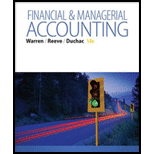
a)
Ratio of liabilities to stockholder's equity:
Ratio of liabilities to stockholders' equity shows the relationship between the liabilities and the
To determine: Total stockholder’s equity at the end of the years 2 and 1 for Company LC.
b)
The ratio of liabilities to stockholders' equity of Company LC.
c)
To derive: A conclusion regarding the margin of protection to the creditors from the ratio of liabilities to stockholders' equity of Company LC.
d)
To Compare: The ratio of liabilities to stockholders' equity of Company LC and Company THD.
Want to see the full answer?
Check out a sample textbook solution
Chapter 1 Solutions
Financial & Managerial Accounting
- Can you solve this general accounting problem with appropriate steps and explanations?arrow_forwardI am trying to find the accurate solution to this general accounting problem with the correct explanation.arrow_forward← Week 1: Homework Question 3 of 4 8.75/10 The project is completed in 2025, and a successful patent is obtained. The R&D costs to complete the project are $113,000. The administrative and legal expenses incurred in obtaining patent number 472-1001-84 in 2025 total $16,000. The patent has an expected useful life of 5 years. Record the costs for 2025 in journal entry form. Also, record patent amortization (full year) in 2025. (Credit account titles are automatically indented when amount is entered. Do not indent manually. If no entry is required, select "No Entry" for the account titles and enter O for the amounts. List all debit entries before credit entries.) Account Titles and Explanation Research and Development Expense Cash (To record research and development costs) Patents Cash (To record legal and administrative costs) Amortization Expense Patents (To record one year's amortization expense) Debit 113000 16000 3200 Credit 113000 16000 3200arrow_forward
- Joe transfers land to JH Corporation for 90% of the stock in JH Corporation worth $20,000 plus a note payable to Joe in the amount of $40,000 and the assumption by JH Corporation of a mortgage on the land in the amount of $100,000. The land, which has a basis to Joe of $70,000, is worth $160,000. a. Joe will have a recognized gain on the transfer of $90,000. b. Joe will have a recognized gain on the transfer of $30,000.c. JH Corporation will have a basis in the land transferred by Joe of $70,000. d. JH Corporation will have a basis in the land transferred by Joe of $160,000. e. None of the above.arrow_forwardPlease provide the correct answer to this general accounting problem using accurate calculations.arrow_forwardCan you solve this general accounting question with accurate accounting calculations?arrow_forward
 Managerial AccountingAccountingISBN:9781337912020Author:Carl Warren, Ph.d. Cma William B. TaylerPublisher:South-Western College Pub
Managerial AccountingAccountingISBN:9781337912020Author:Carl Warren, Ph.d. Cma William B. TaylerPublisher:South-Western College Pub Financial And Managerial AccountingAccountingISBN:9781337902663Author:WARREN, Carl S.Publisher:Cengage Learning,
Financial And Managerial AccountingAccountingISBN:9781337902663Author:WARREN, Carl S.Publisher:Cengage Learning, Managerial Accounting: The Cornerstone of Busines...AccountingISBN:9781337115773Author:Maryanne M. Mowen, Don R. Hansen, Dan L. HeitgerPublisher:Cengage Learning
Managerial Accounting: The Cornerstone of Busines...AccountingISBN:9781337115773Author:Maryanne M. Mowen, Don R. Hansen, Dan L. HeitgerPublisher:Cengage Learning Survey of Accounting (Accounting I)AccountingISBN:9781305961883Author:Carl WarrenPublisher:Cengage Learning
Survey of Accounting (Accounting I)AccountingISBN:9781305961883Author:Carl WarrenPublisher:Cengage Learning



